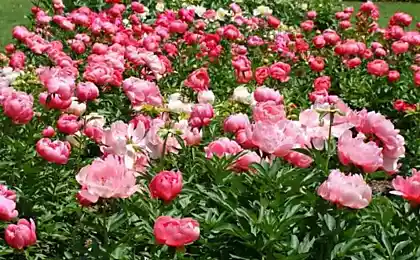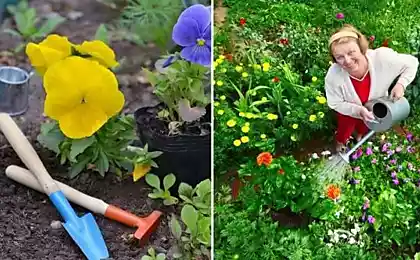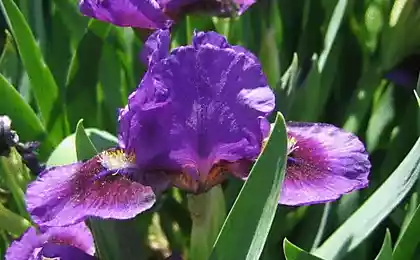1380
How to create a flower bed continuous flowering
Every cottager would dream that his garden was fragrant and pleased stunning views as a more long term as possible. Driving beds of continuous flowering perennials will allow to translate this idea into reality, and throughout the summer to enjoy the beauty and scent of flowers planted.
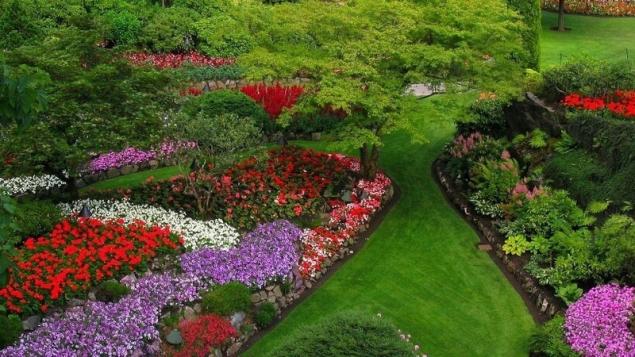
Highlights
Novice gardener question of how to create a flower bed continuous flowering, able to have stalled, however, experienced gardeners know that the secret of its creation is quite simple. In compiling such a flower garden and selecting plants only need to know exactly what time they will bloom. Planting in the garden of a few varieties that will gradually replace each other, you can not worry about what the site will look untidy or empty.
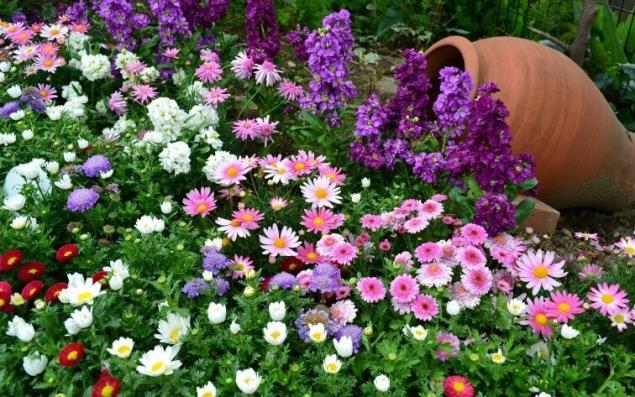
To some it may seem that this is quite an easy job. Indeed, there is nothing easier - to plant flowers with different blooming periods and simply enjoy the work done. But at this point it is important to take into account all the nuances of these flower beds. First of all, taking into account that for each planting is need different care, different degree of irrigation, lighting, soil conditions, and much more. Therefore, when planning mixborders need to pick all those varieties that have similar requirements for care.
Plants for flower beds of continuous flowering, as it became known, are chosen carefully, but even with 5-6 different kinds of plants, you can create an amazing and unique mixborders. The basic rule that it is important to observe how in the preparation of small flower beds, lawns and large, considered to be more or less accurate count of flowering periods. Usually it is not more than a couple of weeks. To smooth over the moment of decay of one blooming buds and others in the garden should be placed and some deciduous plants with high decorative.
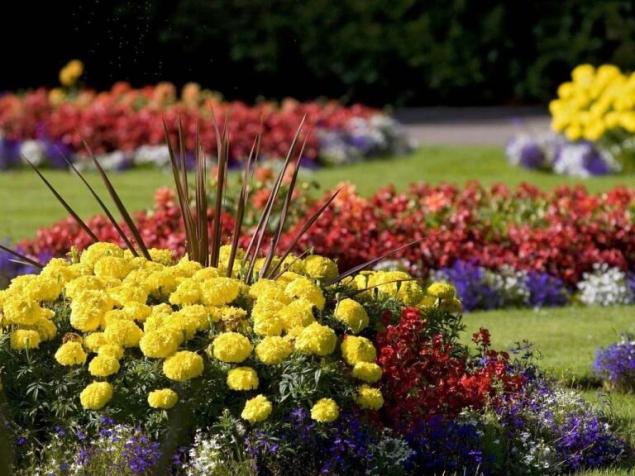
In order to make it easier to navigate, it is better to draw a rough plan on a leaf with a note of the types of flowers that will grow. So, if you intend to create a flower garden in the vast open area garden, the flower beds of perennials bloom continuous scheme should look like this:
The center of the whole composition should be higher grade plants. Here, it is permissible to place plants that do not bloom, but they create a decorative effect. However, their focus in one place is not recommended. It is best to place them in the garden uniformly, so that they grew in a bouquet of flowers.
The closer to the edge, the more crops have to be stunted. At the end of the beds can be planted even small creeping plants on the ground, who are able to conceal the outline and add visual naturalness.
In the selection of different shades sure to observe the compatibility of some shades between them. But at the same time not forget about the bright spots, which are able to attract attention and to place the emphasis thus making even a simple flower-bed of unusual and colorful.
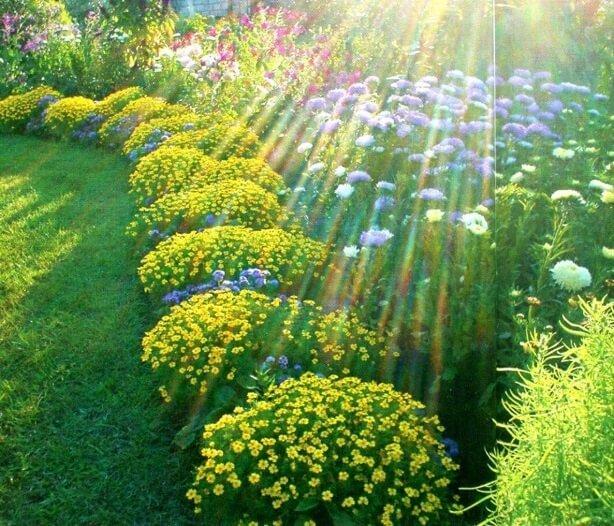
If the placement is expected to make a flower bed near any fence or the fence, then it should be closer to the plant tall crops. Their length also should be reduced in accordance with how far will depart mixborders on the site.
Types of plants used
Examples of continuous flowering beds there are very different, depending on what kind of effect it would be desirable to give the site.
Flower arrangements usually have names that are in tune with the times of year.
Spring tenderness
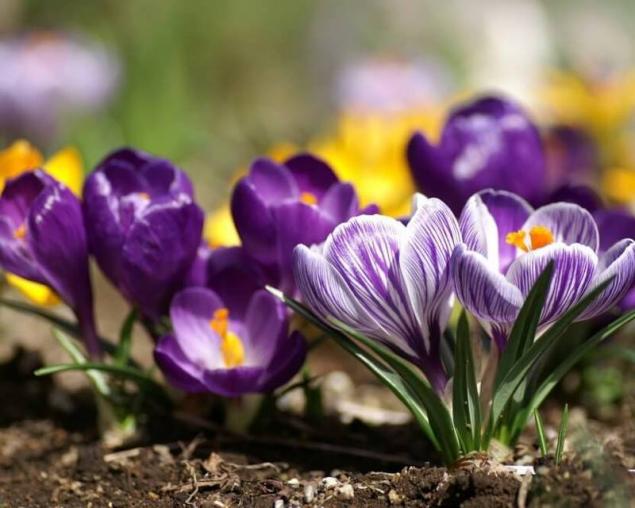
As is known, spring time, many associated with the most delicate flowers sprouting. Therefore, in the flowerbed necessarily important to provide such flowers as daisies, primroses, pansies, daffodils, crocus, tulips, lungwort. These plants bloom almost the very first and please all gardeners at least a month. Gradually, by May they come to replace peonies, later species of tulips and daffodils, Aquilegia, forsythia, lupins and Aquilegia. By the end of this month, gaining strength hyacinths, imperial grouse, sweet peas, as well as other kinds of flowers.
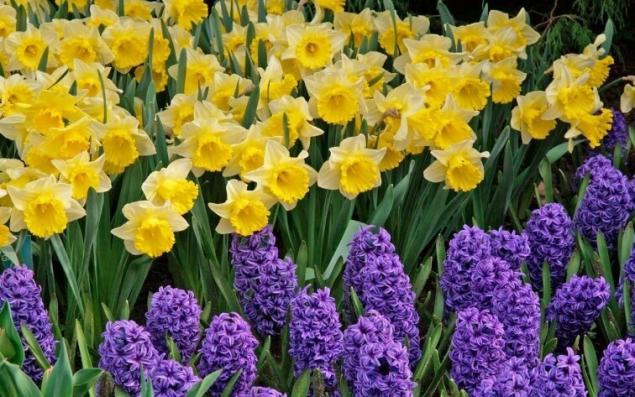
Summer Chic
Gradually replace the one time of year comes another, and the beds can be found already a lot more kinds of variety of colors. For example, you can plant the following plants:
Amaranth;
Marigolds;
Hibiscus;
Gillyflowers;
Zinnias;
Roses;
Hydrangeas;
Liatris;
Delphiniums.
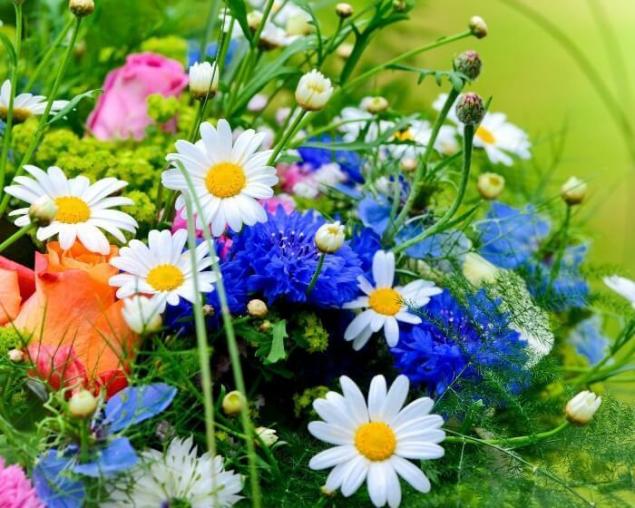
At the same bed of perennials continuous flowering should be drawn up as of the different types of daylilies and lilies, Rudbeckia, Monarda, Echinacea, dead-nettle. The buds of these plants are able to smell almost all summer, unless, of course, for them to exercise proper care. By the way, emerging empty space between them in the spring can be sown annuals. As usual riot of colors can be diluted with new kinds of spaces and to create a more interesting composition.
Autumn
nobility As the decay range of summer colors and the arrival of autumn is the time for new types of flowers. As you might guess, they are needed more in the cool than in the summer heat, so perfectly adapted to this time.
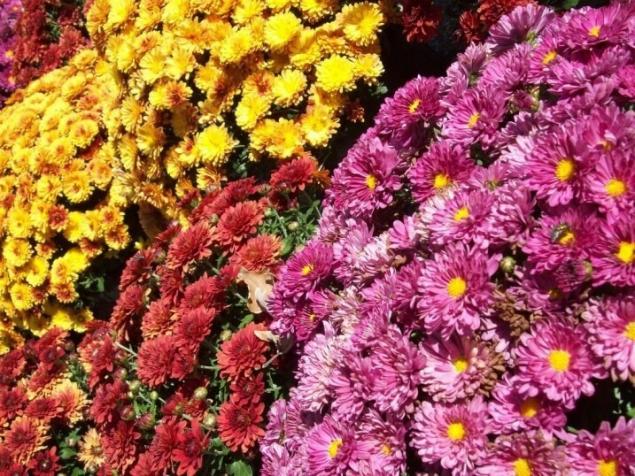
The flower beds are slowly beginning to blossom buds phlox, lobelia, chrysanthemums, Cannes, colchicum. At the same time it can be achieved and some re-bloom flowers. For example, again to please the beautiful fresh buds capable remontant roses, ageratum, carnation, delphinium, begonia. To this end, it is important immediately after wilting flowers shoot faded petals, cutting off their clippers.
If you want to return the garden of the old bright colors, you need to find a place to plant the seeds of sage, coreopsis, helenium, asters and sedum. At the same time in the garden is almost up to the frost can grow crops decorative bow, yarrow, kraspedii.
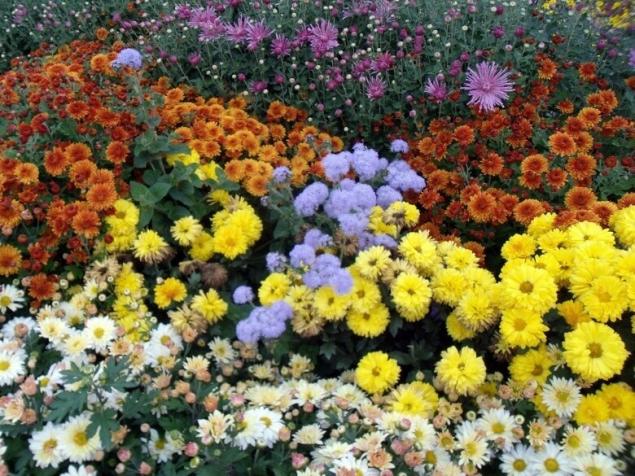
Ready schemes and ideas
There are many different types of flower beds of this kind. Talk is about the most spectacular. By the way, flowerbed continuous flowering with their hands can get a unique, if you develop it yourself.
Create the illusion of
For those gardeners who dream to decorate the construction site of the fountain or a stream, but for some reason could not pull it off, it is possible to construct a fake, but very natural "dry" source.
It is important to work necessarily take into account all the nuances that visually it seemed that the water really runs.
First of all it is necessary to lay out the channel by means of oblong pebbles of different sizes. For more naturalness it can be painted in a blue color to a distance did seem that it is a liquid. At the same time, you can fill the "mainstream" of our brook transparent blue beads.
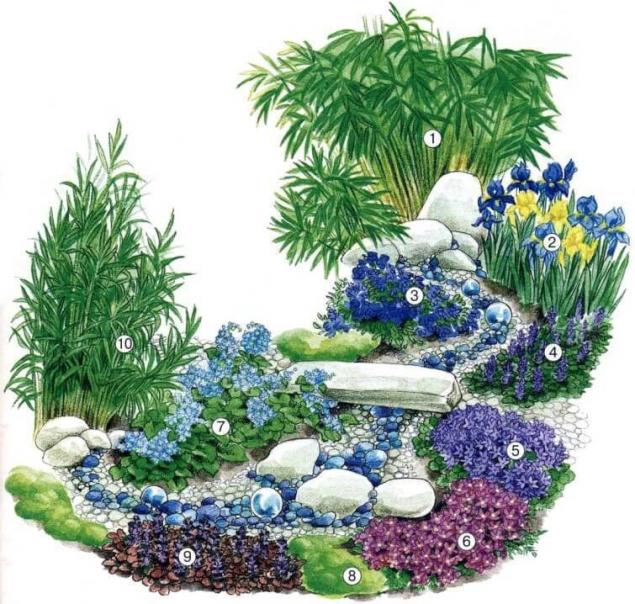
Then all the flowers are planted according to the proposed scheme:
Listokolosnik-bamboo. This is not a flowering plant, but in the composition it plays a key role, as the attached stream naturalness. If you think about it, you will remember that the number of sources grows near these types of herbaceous crops. If the seeds of this plant is not, you can replace it strausnikom. Both of them have the ability to give the volume of flower garden.
Bearded irises are planted close to him in the mouth of the brook.
Rather these types of flowers podsazhivayut lobelia.
A similar care required by creeping zhivuchka located near the iris.
Further, it should provide very short distance, which will only pebbles. Immediately after them on the right side can be planted bell Poskharskogo. It is not too high and perfectly fit into the "mainstream" of our creek.
Aubrieta hybrids can be positioned right next to them, to ensure a smooth transition of colors.
On the left side directly opposite Aubrieta be planted plants, which would be in addition to the green and lush colorful flowers. For example, Brunner macrophylla would be the best choice in this case.
On the opposite shore from this plant will need to plant bryozoans shilolistnuyu. Her soft greens to add the necessary shade and naturalness.
Complete composition will be red creeping zhivuchka. This groundcover planting, which perfectly fit into the whole composition.
The last plant is not flowering. It may be, as in the first case, listokolosnik-bamboo or any other green spaces of this kind.
Composition "for the impatient»
Every cottager would dream to see the fruits of their labors as soon as possible. Of course, with perennials it is quite difficult to achieve in riotous bloom landings a year, but it is possible to do. The most important rule when planting this mixborders be compulsory choice a well-lit side to provide plantings need constant warmth. This mixborders are best planted near the fence. Background, among other things, the same may be coniferous plantations or wall.
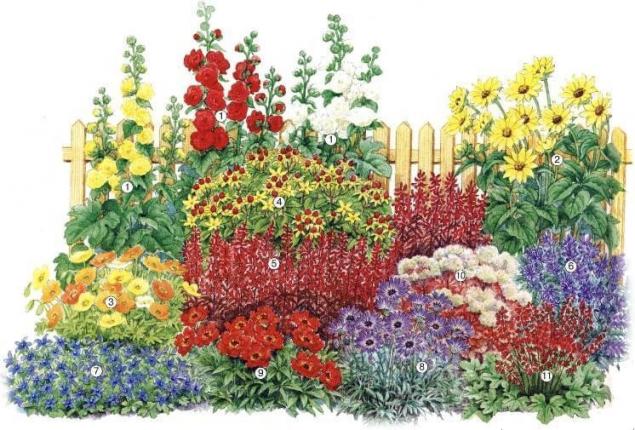
Driving beds of continuous flowering perennials in this case would be as follows:
The background decorated with different types of stem-roses. You can make a mix of different shades;
Decorative sunflowers planted near them;
To give greater brightness capable of Icelandic poppies;
Not far from them are located Gaillardia;
Bright accent - lobelia cardinal. It will run through most of the beds, like a red ribbon;
Blue tones give depth. This will require three varieties of flowers. The first of them - catnip;
Further planted bell Poskharskogo;
On the edge of the need to place the blue katananhe;
Red stains avens;
Sedum is able to please until the autumn;
Just until the frosts will please Heuchera summer resident.
All these flowers are matched to each other as well as possible and in need of general maintenance. Despite the ease of cultivation, you can get a really nice flower bed. If the site has an ugly blank wall or structure, it can be quite easy to hide by using this composition.
Decoration
wicket If your site has a gate with an arch above it, then you can decorate it with flowers, so that throughout the warm season building looked elegant and beautiful. This flower garden all plantings are selected in such a way, so the problems with it not occur.
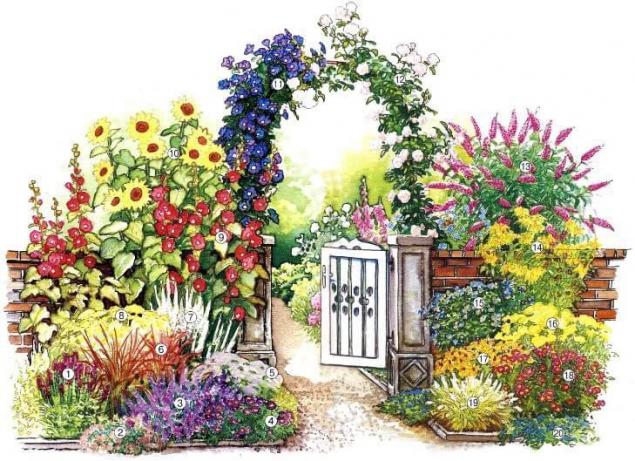
For a better understanding of the whole flower bed should be divided into stages.
The first will be located at the bottom, which will form the basis of creeping densely courtines. To achieve this effect, you can, if you use the bell Pozharsky (20), podushkovituyu aster (3), peristoschetinnik foxtail (19), the sage of Asherah (9), rock stonecrop (2), skripun stonecrop (5).
The average level is based on symmetrically opposite each other yellow yarrow (16 and 8). In the center of the left already need to place longer, compared with the first species of plants and flowers. It is well suited dlinnolistaya Veronica (7), Liatris spicate (1) and switch grass (6). Right in the center of it will be necessary to arrange plantations belonging to romashkopodobnym colors. It can be rudbeckia brilliant (17), novobelgiyskaya (15) and podushkovitaya (18) asters.
The background will already be plant-giants, who are able to hide the fence and rise above it if it is small in size. Sunflower (10) decorate a flower bed with bright shades, the stem-rose (9) dilute summer riot of colors delicate burgundy buds. To the right is best will look glossy rudbeckia (14) and David budleya (13).
Plants to be arch braid should be two colors to give a flavor of the whole composition. Good solution in this case is the use of climbing rose (12) on one side and Zhakmana clematis (11) on the other.
The main difference of such beds is its versatility. It is perfectly able to decorate as stone and wood, wrought iron and other types of fences.
For partial shade
Not every summer visitor has the opportunity to arrange a flower garden on a sunny plot. The next option is suitable just as if the penumbra is constantly present in the garden.
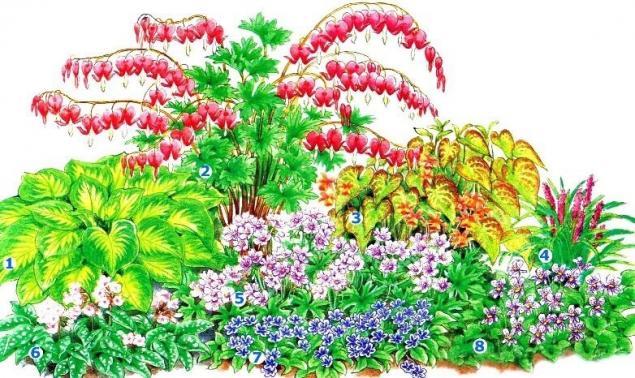
The basic idea of the composition - a dull landscape dilution and striking combination of bright spaces with lush greenery. The unusual combination of colors on the leaves is Funk (1). It will please during the warm period. Already in May blooms luxury lamprocapnos (2), which in any case will look impressive. muskarevidnoe Liriope (4)
- In early June, one of the most prominent focus is on the flower bed begin to appear bright yellow-red leaves red epimediuma (3), and next to him. Beginning in May and almost to the October special mesh pattern will create a geranium (5). Dilutes the delicate shades of lungwort (6). In the spring the emphasis mixborders - it omphalodes spring (7), and to replace it gradually comes no less soft and subtle shades of violet (8)
.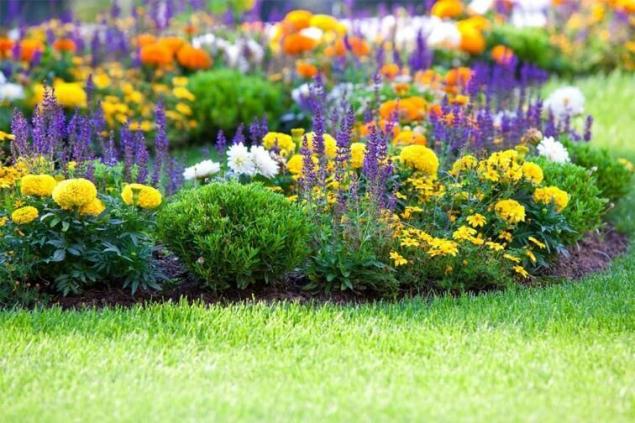
Based on the charts and material from this article, and you can create in the country a beautiful composition of perennial flowers that will delight their flowering throughout the summer. Most importantly - observe all the necessary advice and stick to planting rules. After all, in the preparation of such beds it is very important to select those crops that can well live side by side with each other.

Highlights
Novice gardener question of how to create a flower bed continuous flowering, able to have stalled, however, experienced gardeners know that the secret of its creation is quite simple. In compiling such a flower garden and selecting plants only need to know exactly what time they will bloom. Planting in the garden of a few varieties that will gradually replace each other, you can not worry about what the site will look untidy or empty.

To some it may seem that this is quite an easy job. Indeed, there is nothing easier - to plant flowers with different blooming periods and simply enjoy the work done. But at this point it is important to take into account all the nuances of these flower beds. First of all, taking into account that for each planting is need different care, different degree of irrigation, lighting, soil conditions, and much more. Therefore, when planning mixborders need to pick all those varieties that have similar requirements for care.
Plants for flower beds of continuous flowering, as it became known, are chosen carefully, but even with 5-6 different kinds of plants, you can create an amazing and unique mixborders. The basic rule that it is important to observe how in the preparation of small flower beds, lawns and large, considered to be more or less accurate count of flowering periods. Usually it is not more than a couple of weeks. To smooth over the moment of decay of one blooming buds and others in the garden should be placed and some deciduous plants with high decorative.

In order to make it easier to navigate, it is better to draw a rough plan on a leaf with a note of the types of flowers that will grow. So, if you intend to create a flower garden in the vast open area garden, the flower beds of perennials bloom continuous scheme should look like this:
The center of the whole composition should be higher grade plants. Here, it is permissible to place plants that do not bloom, but they create a decorative effect. However, their focus in one place is not recommended. It is best to place them in the garden uniformly, so that they grew in a bouquet of flowers.
The closer to the edge, the more crops have to be stunted. At the end of the beds can be planted even small creeping plants on the ground, who are able to conceal the outline and add visual naturalness.
In the selection of different shades sure to observe the compatibility of some shades between them. But at the same time not forget about the bright spots, which are able to attract attention and to place the emphasis thus making even a simple flower-bed of unusual and colorful.

If the placement is expected to make a flower bed near any fence or the fence, then it should be closer to the plant tall crops. Their length also should be reduced in accordance with how far will depart mixborders on the site.
Types of plants used
Examples of continuous flowering beds there are very different, depending on what kind of effect it would be desirable to give the site.
Flower arrangements usually have names that are in tune with the times of year.
Spring tenderness

As is known, spring time, many associated with the most delicate flowers sprouting. Therefore, in the flowerbed necessarily important to provide such flowers as daisies, primroses, pansies, daffodils, crocus, tulips, lungwort. These plants bloom almost the very first and please all gardeners at least a month. Gradually, by May they come to replace peonies, later species of tulips and daffodils, Aquilegia, forsythia, lupins and Aquilegia. By the end of this month, gaining strength hyacinths, imperial grouse, sweet peas, as well as other kinds of flowers.

Summer Chic
Gradually replace the one time of year comes another, and the beds can be found already a lot more kinds of variety of colors. For example, you can plant the following plants:
Amaranth;
Marigolds;
Hibiscus;
Gillyflowers;
Zinnias;
Roses;
Hydrangeas;
Liatris;
Delphiniums.

At the same bed of perennials continuous flowering should be drawn up as of the different types of daylilies and lilies, Rudbeckia, Monarda, Echinacea, dead-nettle. The buds of these plants are able to smell almost all summer, unless, of course, for them to exercise proper care. By the way, emerging empty space between them in the spring can be sown annuals. As usual riot of colors can be diluted with new kinds of spaces and to create a more interesting composition.
Autumn
nobility As the decay range of summer colors and the arrival of autumn is the time for new types of flowers. As you might guess, they are needed more in the cool than in the summer heat, so perfectly adapted to this time.

The flower beds are slowly beginning to blossom buds phlox, lobelia, chrysanthemums, Cannes, colchicum. At the same time it can be achieved and some re-bloom flowers. For example, again to please the beautiful fresh buds capable remontant roses, ageratum, carnation, delphinium, begonia. To this end, it is important immediately after wilting flowers shoot faded petals, cutting off their clippers.
If you want to return the garden of the old bright colors, you need to find a place to plant the seeds of sage, coreopsis, helenium, asters and sedum. At the same time in the garden is almost up to the frost can grow crops decorative bow, yarrow, kraspedii.

Ready schemes and ideas
There are many different types of flower beds of this kind. Talk is about the most spectacular. By the way, flowerbed continuous flowering with their hands can get a unique, if you develop it yourself.
Create the illusion of
For those gardeners who dream to decorate the construction site of the fountain or a stream, but for some reason could not pull it off, it is possible to construct a fake, but very natural "dry" source.
It is important to work necessarily take into account all the nuances that visually it seemed that the water really runs.
First of all it is necessary to lay out the channel by means of oblong pebbles of different sizes. For more naturalness it can be painted in a blue color to a distance did seem that it is a liquid. At the same time, you can fill the "mainstream" of our brook transparent blue beads.

Then all the flowers are planted according to the proposed scheme:
Listokolosnik-bamboo. This is not a flowering plant, but in the composition it plays a key role, as the attached stream naturalness. If you think about it, you will remember that the number of sources grows near these types of herbaceous crops. If the seeds of this plant is not, you can replace it strausnikom. Both of them have the ability to give the volume of flower garden.
Bearded irises are planted close to him in the mouth of the brook.
Rather these types of flowers podsazhivayut lobelia.
A similar care required by creeping zhivuchka located near the iris.
Further, it should provide very short distance, which will only pebbles. Immediately after them on the right side can be planted bell Poskharskogo. It is not too high and perfectly fit into the "mainstream" of our creek.
Aubrieta hybrids can be positioned right next to them, to ensure a smooth transition of colors.
On the left side directly opposite Aubrieta be planted plants, which would be in addition to the green and lush colorful flowers. For example, Brunner macrophylla would be the best choice in this case.
On the opposite shore from this plant will need to plant bryozoans shilolistnuyu. Her soft greens to add the necessary shade and naturalness.
Complete composition will be red creeping zhivuchka. This groundcover planting, which perfectly fit into the whole composition.
The last plant is not flowering. It may be, as in the first case, listokolosnik-bamboo or any other green spaces of this kind.
Composition "for the impatient»
Every cottager would dream to see the fruits of their labors as soon as possible. Of course, with perennials it is quite difficult to achieve in riotous bloom landings a year, but it is possible to do. The most important rule when planting this mixborders be compulsory choice a well-lit side to provide plantings need constant warmth. This mixborders are best planted near the fence. Background, among other things, the same may be coniferous plantations or wall.

Driving beds of continuous flowering perennials in this case would be as follows:
The background decorated with different types of stem-roses. You can make a mix of different shades;
Decorative sunflowers planted near them;
To give greater brightness capable of Icelandic poppies;
Not far from them are located Gaillardia;
Bright accent - lobelia cardinal. It will run through most of the beds, like a red ribbon;
Blue tones give depth. This will require three varieties of flowers. The first of them - catnip;
Further planted bell Poskharskogo;
On the edge of the need to place the blue katananhe;
Red stains avens;
Sedum is able to please until the autumn;
Just until the frosts will please Heuchera summer resident.
All these flowers are matched to each other as well as possible and in need of general maintenance. Despite the ease of cultivation, you can get a really nice flower bed. If the site has an ugly blank wall or structure, it can be quite easy to hide by using this composition.
Decoration
wicket If your site has a gate with an arch above it, then you can decorate it with flowers, so that throughout the warm season building looked elegant and beautiful. This flower garden all plantings are selected in such a way, so the problems with it not occur.

For a better understanding of the whole flower bed should be divided into stages.
The first will be located at the bottom, which will form the basis of creeping densely courtines. To achieve this effect, you can, if you use the bell Pozharsky (20), podushkovituyu aster (3), peristoschetinnik foxtail (19), the sage of Asherah (9), rock stonecrop (2), skripun stonecrop (5).
The average level is based on symmetrically opposite each other yellow yarrow (16 and 8). In the center of the left already need to place longer, compared with the first species of plants and flowers. It is well suited dlinnolistaya Veronica (7), Liatris spicate (1) and switch grass (6). Right in the center of it will be necessary to arrange plantations belonging to romashkopodobnym colors. It can be rudbeckia brilliant (17), novobelgiyskaya (15) and podushkovitaya (18) asters.
The background will already be plant-giants, who are able to hide the fence and rise above it if it is small in size. Sunflower (10) decorate a flower bed with bright shades, the stem-rose (9) dilute summer riot of colors delicate burgundy buds. To the right is best will look glossy rudbeckia (14) and David budleya (13).
Plants to be arch braid should be two colors to give a flavor of the whole composition. Good solution in this case is the use of climbing rose (12) on one side and Zhakmana clematis (11) on the other.
The main difference of such beds is its versatility. It is perfectly able to decorate as stone and wood, wrought iron and other types of fences.
For partial shade
Not every summer visitor has the opportunity to arrange a flower garden on a sunny plot. The next option is suitable just as if the penumbra is constantly present in the garden.

The basic idea of the composition - a dull landscape dilution and striking combination of bright spaces with lush greenery. The unusual combination of colors on the leaves is Funk (1). It will please during the warm period. Already in May blooms luxury lamprocapnos (2), which in any case will look impressive. muskarevidnoe Liriope (4)
- In early June, one of the most prominent focus is on the flower bed begin to appear bright yellow-red leaves red epimediuma (3), and next to him. Beginning in May and almost to the October special mesh pattern will create a geranium (5). Dilutes the delicate shades of lungwort (6). In the spring the emphasis mixborders - it omphalodes spring (7), and to replace it gradually comes no less soft and subtle shades of violet (8)
.

Based on the charts and material from this article, and you can create in the country a beautiful composition of perennial flowers that will delight their flowering throughout the summer. Most importantly - observe all the necessary advice and stick to planting rules. After all, in the preparation of such beds it is very important to select those crops that can well live side by side with each other.
First aid without drugs - advice of traditional medicine
Rose Arden She is now 104 years old and rejuvenation process does not stop.
















